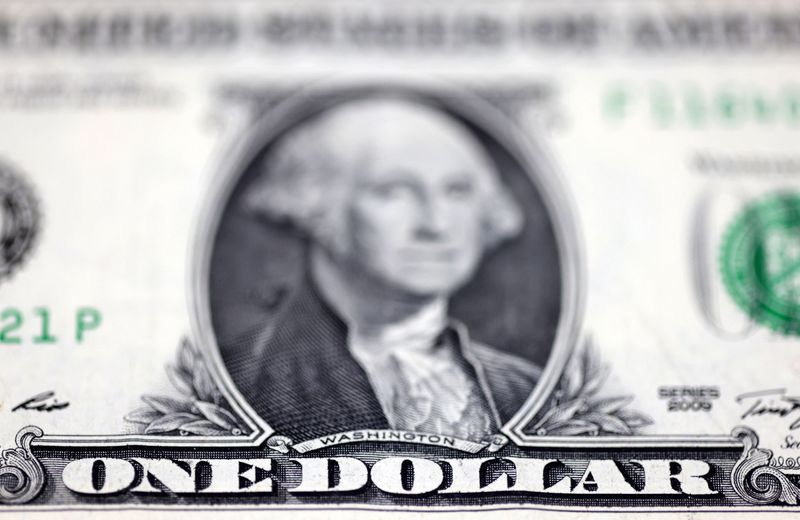Forex
Dollar index falls as traders weigh Fed rate path

© Reuters
Investing.com – The dollar dipped in European trade on Thursday, as markets remained on edge before key U.S. labor data, while the yen appreciated as Bank of Japan Governor Kazuo Ueda offered more cues on a potential pivot away from the central bank’s ultra-dovish stance.
At 06:42 ET (11:42 GMT), the , which tracks the greenback against a basket of six other currencies, traded 0.2% lower at 103.94.
“The underlying dollar story […] will be determined, by tomorrow’s US jobs report and next week’s [Federal Open Market Committee] meeting,” analysts at ING said in a note.
While the Fed is widely projected to keep interest rates on hold in December, markets have been unsure when the U.S. central bank plans to begin trimming borrowing costs. The uncertainty has aided the dollar, even as data pointed to more cooling in the labor market.
report due on Friday is expected to provide definitive clues about the jobs picture in the world’s largest economy, and will likely factor into the trajectory of the dollar for the remainder of the year.
Yen in focus in Asia
The was the best performer in Asia for the day, strengthening by 1.6% against the greenback after Ueda flagged more challenges for the BOJ in the coming months, and also spoke about options the bank has when considering a move away from negative interest rates.
His comments reinforced expectations that the BOJ will wind down its ultra-dovish, stimulus-heavy policies in the coming year. But the unclear timing of the pivot kept traders wary.
Gains in the yen were still held back by Ueda stressing the need for loose policy in the near-term, especially amid signs that the Japanese economy was cooling further.
Yuan flat after mixed trade data, FX intervention eyed
The was steady in Asian trade on Thursday after data showed a bigger-than-expected improvement in China’s through November. Chinese rose for the first time in six months, albeit marginally.
But an unexpected drop in fueled concerns over easing domestic demand, especially as economic activity in the country remained languid. A string of readings for November, released earlier this month, exacerbated worries over sustained weakness in China’s economy.
Traders were also watching for any more currency market intervention by the Chinese government, after several state banks were seen selling dollars for yuan on the open market.
Swiss franc surges versus euro
The inched only marginally higher against the dollar and slumped to its lowest level since January 2015, as markets eyed the potential for early rate cuts by the European Central Bank next year following a string of weak economic data.
Recent figures have suggested that the eurozone economy may be heading into a recession in the final quarter of this year, after it contracted by 0.1% in the prior three month period.
On Thursday, numbers from Germany’s federal statistics office showed that industrial production in Europe’s largest economy dropped for the fifth consecutive month in October. Factory orders in the country also contracted by 3.7% in October, reversing a gain of 0.7% in September, according to separate data earlier this week.
Across the eurozone, retail sales inched up by 0.1% in October, below economists’ estimates for an uptick of 0.2%, hinting at a soft consumer spending environment heading into the key holiday shopping season.
A possible slowdown, coupled with inflation across the eurozone falling more quickly than most anticipated, has led many observers to suspect that the European Central Bank could deliver its first rate cut by March.
Ambar Warrick contributed to this report.

 Forex3 years ago
Forex3 years agoForex Today: the dollar is gaining strength amid gloomy sentiment at the start of the Fed’s week

 Forex3 years ago
Forex3 years agoUnbiased review of Pocket Option broker

 Forex3 years ago
Forex3 years agoDollar to pound sterling exchange rate today: Pound plummeted to its lowest since 1985

 Forex3 years ago
Forex3 years agoHow is the Australian dollar doing today?

 Cryptocurrency3 years ago
Cryptocurrency3 years agoWhat happened in the crypto market – current events today

 World3 years ago
World3 years agoWhy are modern video games an art form?

 Commodities3 years ago
Commodities3 years agoCopper continues to fall in price on expectations of lower demand in China

 Economy3 years ago
Economy3 years agoCrude oil tankers double in price due to EU anti-Russian sanctions





















